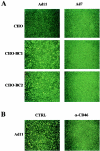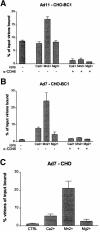Adenovirus type 11 uses CD46 as a cellular receptor
- PMID: 12915534
- PMCID: PMC187375
- DOI: 10.1128/jvi.77.17.9183-9191.2003
Adenovirus type 11 uses CD46 as a cellular receptor
Abstract
The 51 human adenovirus serotypes are divided into six species (A to F). Many adenoviruses use the coxsackie-adenovirus receptor (CAR) for attachment to host cells in vitro. Species B adenoviruses do not compete with CAR-binding serotypes for binding to host cells, and it has been suggested that species B adenoviruses use a receptor other than CAR. Species B adenoviruses mainly cause disease in the respiratory tract, the eyes, and in the urinary tract. Here we demonstrate that adenovirus type 11 (Ad11; of species B) binds to Chinese hamster ovary (CHO) cells transfected with CD46 (membrane cofactor protein)-cDNA at least 10 times more strongly than to CHO cells transfected with cDNAs encoding CAR or CD55 (decay accelerating factor). Nonpermissive CHO cells were rendered permissive to Ad11 infection upon transfection with CD46-cDNA. Soluble Ad11 fiber knob but not Ad7 or Ad5 knob inhibited binding of Ad11 virions to CD46-transfected cells, and anti-CD46 antibodies inhibited both binding of and infection by Ad11. From these results we conclude that CD46 is a cellular receptor for Ad11.
Figures







Similar articles
-
CD46 is a cellular receptor for all species B adenoviruses except types 3 and 7.J Virol. 2005 Nov;79(22):14429-36. doi: 10.1128/JVI.79.22.14429-14436.2005. J Virol. 2005. PMID: 16254377 Free PMC article.
-
The human membrane cofactor CD46 is a receptor for species B adenovirus serotype 3.J Virol. 2004 May;78(9):4454-62. doi: 10.1128/jvi.78.9.4454-4462.2004. J Virol. 2004. PMID: 15078926 Free PMC article.
-
Membrane cofactor protein is a receptor for adenoviruses associated with epidemic keratoconjunctivitis.J Virol. 2004 Apr;78(8):3897-905. doi: 10.1128/jvi.78.8.3897-3905.2004. J Virol. 2004. PMID: 15047806 Free PMC article.
-
Human regulator of complement activation (RCA) gene family proteins and their relationship to microbial infection.Microbiol Immunol. 1995;39(5):295-305. doi: 10.1111/j.1348-0421.1995.tb02205.x. Microbiol Immunol. 1995. PMID: 7565169 Review. No abstract available.
-
Tropism and transduction of oncolytic adenovirus 5 vectors in cancer therapy: Focus on fiber chimerism and mosaicism, hexon and pIX.Virus Res. 2018 Sep 15;257:40-51. doi: 10.1016/j.virusres.2018.08.012. Epub 2018 Aug 17. Virus Res. 2018. PMID: 30125593 Review.
Cited by
-
Adenoviral producer cells.Viruses. 2010 Aug;2(8):1681-1703. doi: 10.3390/v2081681. Epub 2010 Aug 16. Viruses. 2010. PMID: 21994701 Free PMC article.
-
Clathrin adaptor AP1B controls adenovirus infectivity of epithelial cells.Proc Natl Acad Sci U S A. 2009 Jul 7;106(27):11143-8. doi: 10.1073/pnas.0811227106. Epub 2009 Jun 19. Proc Natl Acad Sci U S A. 2009. PMID: 19549835 Free PMC article.
-
A novel bladder cancer - specific oncolytic adenovirus by CD46 and its effect combined with cisplatin against cancer cells of CAR negative expression.Virol J. 2017 Aug 8;14(1):149. doi: 10.1186/s12985-017-0818-1. Virol J. 2017. PMID: 28789701 Free PMC article.
-
The Arg279Gln [corrected] substitution in the adenovirus type 11p (Ad11p) fiber knob abolishes EDTA-resistant binding to A549 and CHO-CD46 cells, converting the phenotype to that of Ad7p.J Virol. 2006 Feb;80(4):1897-905. doi: 10.1128/JVI.80.4.1897-1905.2006. J Virol. 2006. PMID: 16439545 Free PMC article.
-
Cellular receptor for Pixuna virus in chicken embryonic fibroblasts.Med Microbiol Immunol. 2006 Jun;195(2):85-92. doi: 10.1007/s00430-005-0004-8. Epub 2005 Oct 12. Med Microbiol Immunol. 2006. PMID: 16220309
References
-
- Arcasoy, S. M., J. Latoche, M. Gondor, S. C. Watkins, R. A. Henderson, R. Hughey, O. J. Finn, and J. M. Pilewski. 1997. MUC1 and other sialoglycoconjugates inhibit adenovirus-mediated gene transfer to epithelial cells. Am. J. Respir. Cell Mol. Biol. 17:422-435. - PubMed
-
- Arnberg, N., A. H. Kidd, K. Edlund, J. Nilsson, P. Pring-Åkerblom, and G. Wadell. 2002. Adenovirus type 37 binds to cell surface sialic acid through a charge-dependent interaction. Virology 302:33-43. - PubMed
Publication types
MeSH terms
Substances
LinkOut - more resources
Full Text Sources
Other Literature Sources
Molecular Biology Databases
Miscellaneous

